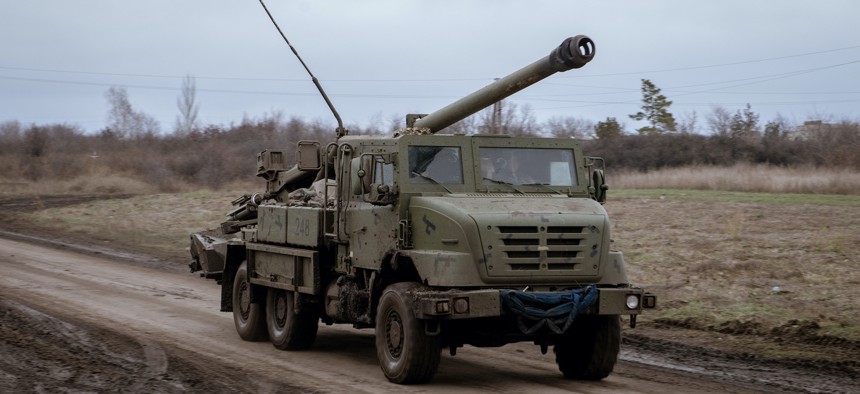
A 155mm truck-mounted howitzer in Ukraine on December 4, 2023. Andre Luis Alves / Anadolu via Getty Images
It takes Europe at least a year to fill a Ukrainian order for artillery shells
And it's hard to buy 155mm ammunition from non-Western nations that make it, the Estonian defense ministry’s top civil servant said.
While Europe is getting faster at making artillery shells, orders placed for Ukraine still take a year or more to reach the country, according to the Estonian defense ministry.
“If we would go under contract today, then it’s 12 to 18 months" for 155mm delivery, Kusti Salm, Estonia's permanent secretary, said in a Friday interview at his country's embassy in Washington, D.C.
Last year, the French parliament cited delivery times of 10 to 20 months.
Ukraine has reported shortages of 155mm shells since November, as Russia presses an offensive in the eastern city of Avdiivka.
“In a year, we will have something that we ordered today,” Salm said, referring to 155mm shells. “And if we don't do it today, then there's another year we don’t have it.”
European Union members can also purchase 155mm shells for Ukraine from outside the EU. Pakistan, India and South Korea all make the shells.
However, it has been difficult to supply Ukraine with 155mm shells from outside the EU, Salm said. That’s due to the desire to buy European, a lack of European orders, and “another very large obstacle in the room: that is, the willingness of third countries to actually sell,” Salm said.
“This is something that needs a lot of effort to overturn,” he said, “I would assume that a lot of this is associated with international relations with Russia.”
Many countries have provided Ukraine with Soviet-standard munitions, but after two years of war, those munitions are “drying out,” Salm said.
An Estonian plan for Ukrainian victory, released in December, calls for higher production of munitions as well as artillery barrels, which wear out with repeated fire. The plan also calls for more training for Ukrainian staff officers, following reports by think tank RUSI that operational planning was hampered by a lack of qualified leaders.
“The common denominator of all the solutions is more money,” said Salm. “There needs to be more money [for Ukraine]”
The average cost for a 155mm shell is around $5,000, Salm said. The U.S. M795 high explosive shell, the most basic type of 155mm shell, costs around $3,000, according to an Army spokesperson.
In December, the U.S. announced the last of the munitions available to Ukraine through the Presidential Drawdown Assistance program. Under the program, the U.S. has sent old weapons to Ukraine and purchased new ones for U.S. stocks.
The Senate on Tuesday passed a bill to send more aid to Ukraine, but Republican leadership in the House has already signaled it will vote against the legislation because it lacks strict immigration measures.
Republican opposition to Ukraine aid comes amid widespread skepticism toward Ukraine among Republican voters and isolationist policies proposed by presumptive Republican presidential nominee Donald Trump.
As U.S. support wanes, Russian intermediaries have reportedly offered surrender terms to Ukraine that would see Kyiv lose all Russian-occupied territory, as well as the Ukrainian-held city of Kharkiv and possibly Odesa, according to the think tank RUSI. The two cities are respectively the second and third largest in Ukraine.
Europe will deliver just over half of the one million 155mm rounds it promised to deliver to Ukraine by March 2024, EU top diplomat Josep Borrell said in January. The EU should reach its target by the end of 2024, he said.
However, both Borrell and Salm emphasized that the effort has increased European munitions manufacturing capacity. Borrell noted that production had grown by 40 percent since the beginning of Russia’s full scale invasion in February 2022.
By the end of this year, Europe will be able to manufacture around 1.4 million 155mm rounds a year, Borrell added.
Once Congress approves funds for Ukraine, the U.S. will be able to manufacture 1.2 million 155mm rounds by October 2025.
Assuming a maximum production rate, the U.S. and EU would manufacture 2.6 million 155mm rounds per year by 2025. Russian production capacity for 152mm rounds, the Soviet equivalent to 155mm, is estimated to grow to 1.3 million by the end of 2024.


